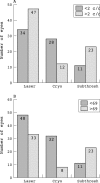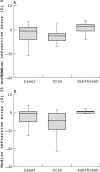Treated threshold stage 3 versus spontaneously regressed subthreshold stage 3 retinopathy of prematurity: a study of motility, refractive, and anatomical outcomes at 6 months and 36 months
- PMID: 15665344
- PMCID: PMC1772499
- DOI: 10.1136/bjo.2004.045815
Treated threshold stage 3 versus spontaneously regressed subthreshold stage 3 retinopathy of prematurity: a study of motility, refractive, and anatomical outcomes at 6 months and 36 months
Abstract
Aim: To compare the visual acuity (VA), spherical equivalent refractive error, motility, and anatomical outcomes in children with treated regressed threshold stage 3 retinopathy of prematurity (ROP) and those with spontaneously regressed subthreshold stage 3 ROP.
Method: 6 month and 3 year data collected from infants examined between 1989 and 1999 with regressed stage 3 ROP, with or without treatment were retrospectively reviewed.
Results: 85 infants were included in this study. 40 eyes received cryotherapy, 81 eyes laser photocoagulation, and 34 eyes had spontaneously regressed subthreshold stage 3 ROP. Grating acuity score > or =2 cycles/degree (c/d) at 6 months was predictive of optotype acuity > or =6/9 in 69% of eyes and a score <2 c/d at 6 months was predictive of acuity < 6/9 in 88% of eyes. Eyes with subthreshold stage 3 ROP were twice as likely to have VA of 6/9 or better at 36 months than the treated eyes. The mean spherical equivalent refractive error at 36 months was -6.5 dioptres (D) (-21.5D to +1.38D) in cryotherapy treated eyes, -2.4D (-13D to +4D) in the laser group, and -0.22D (-9D to +2.25D) in the subthreshold group. Eyes within the treated groups were more myopic than the eyes within the spontaneously regressed group (p = 0.005). At 36 months, 42 out of the 85 infants (that is, 49%) had strabismus (44% in the cryotherapy group, 26% in the laser group, and 25% in the subthreshold group). There was a statistically significant association between the presence of strabismus and anisometropia (p = 0.016) and strabismus and intraventricular haemorrhage (IVH) (p = 0.005). There was a statistically significant difference in the incidence of strabismus between mild and moderate and severe grade IVH (p = 0.01). Eight out of 40 eyes in the cryotherapy group and six out of the 81 eyes in the laser group developed macular ectopia. None of the eyes in the spontaneously regressed group had macular dragging.
Conclusions: In this study, the grating acuity at 6 months was a good predictor of the 3 year optotype acuity in all groups. Eyes with spontaneously regressed subthreshold stage 3 ROP were associated with better vision at 3 years of age and a lesser degree of myopia compared to the treated groups. Strabismus developed predominantly in the treated groups and was frequently associated with neurological damage and/or anisometropia. The spontaneously regressed subthreshold stage 3 group had a better anatomical outcome compared to the groups in which the retinopathy regressed following treatment.
Figures


Comment in
-
Retinopathy of prematurity's turning point.Br J Ophthalmol. 2005 Feb;89(2):127-8. doi: 10.1136/bjo.2004.058560. Br J Ophthalmol. 2005. PMID: 15665336 Free PMC article. No abstract available.
Similar articles
-
Myopia, visual acuity and strabismus in the long term following treatment of retinopathy of prematurity.Turk J Pediatr. 2014 Sep-Oct;56(5):518-23. Turk J Pediatr. 2014. PMID: 26022588
-
Refractive errors and ocular motility disorders in preterm babies with and without retinopathy of prematurity.Ophthalmologica. 1999;213(5):295-9. doi: 10.1159/000027442. Ophthalmologica. 1999. PMID: 10516517
-
Therapeutic outcomes of cryotherapy versus transpupillary diode laser photocoagulation for threshold retinopathy of prematurity.J AAPOS. 1999 Aug;3(4):234-40. doi: 10.1016/s1091-8531(99)70008-x. J AAPOS. 1999. PMID: 10477226
-
Long term functional and structural outcomes of laser therapy for retinopathy of prematurity.Br J Ophthalmol. 2006 Jun;90(6):754-9. doi: 10.1136/bjo.2005.068304. Br J Ophthalmol. 2006. PMID: 16714267 Free PMC article. Review.
-
Ocular sequelae in premature infants.Pediatrics. 1993 Dec;92(6):787-90. Pediatrics. 1993. PMID: 8233737 Review.
Cited by
-
Effect of Grade I and II intraventricular hemorrhage on visuocortical function in very low birth weight infants.Seeing Perceiving. 2012;25(2):143-54. doi: 10.1163/187847612X626381. Seeing Perceiving. 2012. PMID: 22371027 Free PMC article.
-
Refractive status, biometric components, and functional outcomes of patients with threshold retinopathy of prematurity: systemic review and a 17-year longitudinal study.Graefes Arch Clin Exp Ophthalmol. 2022 Dec;260(12):3809-3816. doi: 10.1007/s00417-022-05730-6. Epub 2022 Jun 22. Graefes Arch Clin Exp Ophthalmol. 2022. PMID: 35729410
-
The neurovascular retina in retinopathy of prematurity.Prog Retin Eye Res. 2009 Nov;28(6):452-82. doi: 10.1016/j.preteyeres.2009.06.003. Epub 2009 Jun 27. Prog Retin Eye Res. 2009. PMID: 19563909 Free PMC article. Review.
-
Structural and functional results of indirect diode laser treatment for retinopathy of prematurity from 1999 to 2003 in Kuwait.Clin Ophthalmol. 2013;7:271-8. doi: 10.2147/OPTH.S38915. Epub 2013 Feb 4. Clin Ophthalmol. 2013. PMID: 23403936 Free PMC article.
-
Outcomes after Intravitreal Bevacizumab versus Laser Photocoagulation for Retinopathy of Prematurity: A 5-Year Retrospective Analysis.Ophthalmology. 2015 May;122(5):1008-15. doi: 10.1016/j.ophtha.2014.12.017. Epub 2015 Feb 14. Ophthalmology. 2015. PMID: 25687024 Free PMC article.
References
-
- Cryotherapy for Retinopathy of Prematurity Cooperative Group. Multicentre trial of cryotherapy for retinopathy of prematurity. 3.5 year outcome—structure and function. Arch Ophthalmol 1993;111:339–44. - PubMed
-
- Connolly BP, McNamara JA, Sharma S, et al. A comparison of laser photocoagulation with trans-scleral cryotherapy in the treatment of threshold retinopathy of prematurity. Ophthalmology 1998;105:1628–31. - PubMed
-
- Ng EY, Connolly BP, McNamara JA, et al. A comparison of laser photocoagulation with cryotherapy for threshold retinopathy of prematurity at 10 years: part 1. Visual function and structural outcome. Ophthalmology 2002;109:831–3. - PubMed
MeSH terms
LinkOut - more resources
Full Text Sources
Medical
